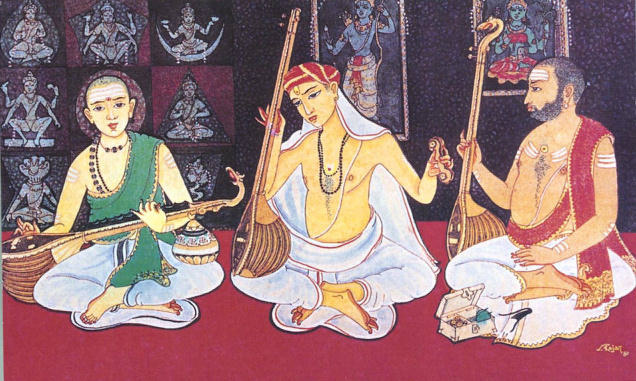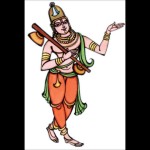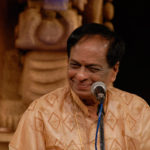“Greatest Classical Composer”, “Indefatigable Interpreter of the Past”, “Incarnation of Valmiki”. These are just some of the many praises and titles attached to Sri Thyagaraja.
Thyagaraja or Thyagayya (as he is known to us Telugus), is one of the greatest exponents of Carnatic music, one of the greatest devotees of Lord Rama, and one of the greatest elevators of the Telugu language.
[The following is a guest post by Krishnarjun garu giving a biographical sketch of one of our greatest Telugu Saints and composers].
What is bhakthi without rasa and what is rasa without music?
The bhakthi bhava springs from the heart, combined with raga brings emotion to the words and the tala ensures the flow of emotion in right doses for the experience of rasa, the joy of soul. Music is a combination of bhava, raga, tala that culminates into experience of rasa.
Bhakthi is considered both highest and the most simple path of yoga to practice and experience divinity within oneself and in creation. It is about emotions of love, gratitude, loyalty, service, and friendship towards the divine. These emotions find an expression through music; it’s an expression and also a source of emotion, a process and medium to communicate emotion between souls. So, music cannot be separated from the path of bhakthi, it’s the language and joy of soul.
Bharat bhumi has been blessed with many great souls who took up the path of bhakthi and inspired world through their profound writings, conduct and action. Many of them composed kirthanas in praise of the innumerable qualities of the divine and expressed their feelings towards the divine. They were inspired by the puranic legends of bhakthi like Narada, Prahlada, Dhruva, Ambareesha and the divine leela associated with their relationship to Lord. The itihasas and the Avataras of the Lord gave them the taste for the divine qualities of the Lord and the assurance in their path. They deeply influenced society with their kirthanas, bhajans and conduct.
Telugu country [ancient Andhra desa] was home to great devotees of the Lord who composed kirthanas rich in bhakthi bhava and sweetness of language. Their compositions are very popular not just among Telugu speaking populations but also among devotees and practitioners of Carnatic music in South India.
Background
Thyagaraja was born as Kakarla, Thyagabrahmam in a Telugu Brahmin family that migrated to Thiruvaiyaru from Prakasam district in 1767. He received his early music lessons from his guru Sonti, Venkata Ramanayya.
Thyagaraja was an ardent devotee of Lord Rama. His desire was to sing the qualities of Rama, but was not able to find the natural flair of music to express his bhakthi bhava. Legend says his prayer for the gift of music was answered when Sage Narada visited him in disguise and gifted him Swararnava, a treatise on music.
Thyagaraja felt it’s the bhava that’s the soul of a kirthana and only proper mix of bhava, raga, tala can create the right devotional mood. The popularity of his kirthanas reached the ruler of Thiruvaiyaru, he invited Thyagaraja to perform at the royal court. Thyagaraja politely declined the rare invitation saying his music was dedicated only to Lord Rama. His elder brother who had great hopes on his mundane achievements was disappointed.
The popular kirthana “nidhi chala sukhama” came out of this predicament. Dissatisfied with his lack of interest in mundane affairs, Thyagaraja’s elder brother secretly bundled the vigrahas of Rama and Sita he was worshipping and immersed them in Cauvery. Unable to bear the separation from his Lord, Thyagayya left home, wandered and visited holy places performing his kirthanas. In a dream Lord advised him to return to Thiruvaiyaru for Sri Rama Navami celebrations and on his way back he found his vigrahas in Cauvery that was flooding his way.
Achievements
Thyagayya composed close to 24,000 kirthanas in his life time but only 700 kirthanas survived the vagaries of time. He also wrote two musical plays in Telugu “Prahlada bhakthi Vijayam” and “Nauka Charitram”. His Pancharatna (five gems) Krithis are considered finest gems of Carnatic music. [He famously composed his first song, “Namo Namo Raghavayya”, at age 13]
The language of Thyagaraja compositions is simple but yet beautiful, and the choice of words in the compositions add to the melody of raga and the rhythm of tala to create the ecstasy of bhava and rasa. His unflinching devotion has brought out the best of his innate genius to describe the qualities of maryada purushottama Rama. His life has similarity with another great devotee of Sri Rama, Sri Bommera Pothana, who translated Srimad Bhagavatam to Telugu in sweetest words. Both refused royal patronage and dedicated their works to their Ishta Daivata, Rama.
[Among his greatest and most popular Krithis are“endaro mahanubavulu”, “sadhincene O manasa”, “kana kanar rucira”, “raga sudha rasa” and “jagadananda karaka”. See here for a full list of compositions]
Legacy
Thyagaraja is foremost among prominent Telugu vageyakaras whose compositions are popular not only among Telugu speaking people but across carnatic music lovers and devotees in south India. He is considered as one of the trinity of Carnatic music along with Syama Shastri and Muthuswamy Deekshitar. [Of the 3 greatest composers of the Carnatic Tradition, Thyagaraja (pictured in center) is the most famous and celebrated ].
Every year in the month of January and February a music festival, Thyagaraja Aradhana, is held in Thiruvaiyaru to celebrate and honour his musical genius. On Pushya Bahula Panchami thousands sing his Pancharatnas together. Now it’s a worldwide event, Thyagaraja aradhana is conducted world wide by the patrons and practitioners of Carnatic music and attended by thousands of music lovers and devotees. There is a classic movie on the life and work of Thyagaraja in telugu with actor Chitoor Nagaiah in the lead role of Thyagayya.
It’s our responsibility to preserve and add more to this rich cultural heritage of devotion and music. The divinity in existence expresses itself in this sublime art and it gives an opportunity to practitioner to immerse the soul and experience the divinity. One should hope the future paves the way for a society that cares more for aesthetics, art, and devotion in life so that more geniuses and devotees like Thyagaraja would emerge.
References:
- http://www.thehindu.com/todays-paper/tp-features/tp-editorialfeatures/the-musical-triumvirate/article1119668.ece
- http://www.poemhunter.com/tyagaraja/biography/
- http://www.thehindu.com/todays-paper/tp-national/tp-tamilnadu/musicians-pay-homage-to-saint-thyagaraja/article4367662.ece
- http://www.thehindu.com/todays-paper/tp-features/tp-editorialfeatures/the-bhaktha-who-craved-more-bhakthi/article4363222.ece
- http://www.thehindu.com/todays-paper/tp-features/tp-fridayreview/tiruvaiyaru-gears-up/article3216630.ece
- http://www.thyagaraja.org/
The author of this post, Krishnarjun garu, can be reached on twitter and at his personal blog.
Disclaimer: This article represents the opinions and work of the Author, and should not be considered a reflection of the views or responsibility of the Andhra Cultural Portal.








A good article. A must read for present generation